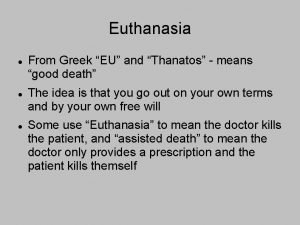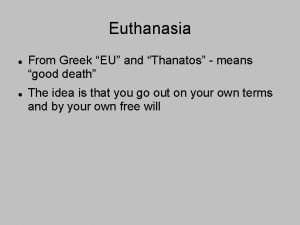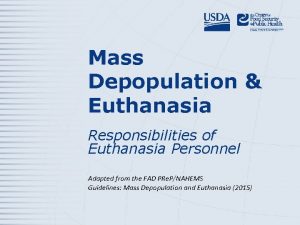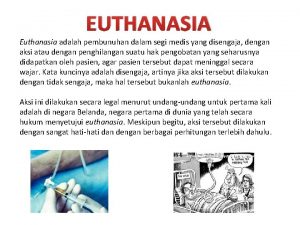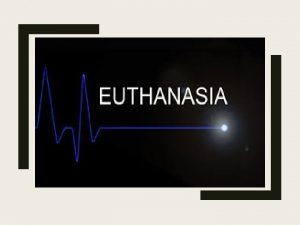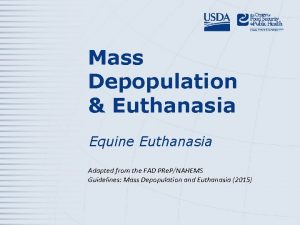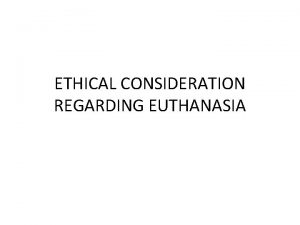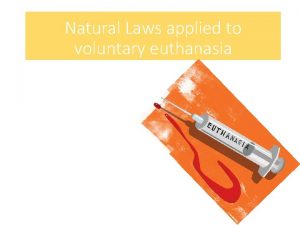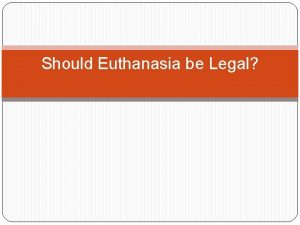Euthanasia The Final Moments What is Euthanasia Euthanasia




























- Slides: 28

Euthanasia The Final Moments

What is Euthanasia? • Euthanasia = “Pertaining to a Good Death” • Using the means of Barbiturates or Inhalant Anesthetics (Isoflurane) to overdose the animal. • Barbiturates are given Intravenously or Intracardiac after a sedative has been injected. • Inhalant Anesthetics are breathed in whether during surgery or in an enclosed container (pocket pets).

How Does It Work? • Once the solution is injected (or inhaled), the animal’s body begins to relax. • They will then quickly stop their breathing. Their diaphragm and intercostal muscles will become paralyzed. • The heart is next, slowing until it stops. • The last function to cease is nervous activity

Pentobarbitol • Common Name: Euthasol • HIGHLY Controlled Drug (Class III) • Given either into the vein or directly into the heart. • It is ideal for animals to be sedated prior to be given this drug. • Euthasol must not ever leave the vein. It will burn outside of the vein. • Some animals can have a bad reaction to Euthasol, hence the need for a sedative. (Some vets will euthanize without sedation. )

Euthasol comes in a variety of brightly colored liquids so that it will not confused with other medications. • Neon Pink • Neon Blue • Neon Orange • Purple

Making the Decision Making the decision to euthanize (Put To Sleep) an animal is an extremely difficult decision. It is hard on both the client and the veterinary staff, especially if you have known the animal for a long period of time. As a Veterinary Assistant, you are to NEVER talk a client into or out of the decision. That is the Veterinarian’s job.

How Do We Know When it’s the Right Time? • There is nothing in this field more important than the well-being of our patients. • Keeping an animal well past its time could result in the suffering of the pet. • The decision to euthanize must not be a selfish one. • We want to keep our pets forever, but there must be a time to finally let them go.

How Do We Know When it’s the Right Time? • Signs that it is time to think about euthanasia: • Unable to hold their bladder and bowels. • Unable to stand on their own for short periods of time. • Extremely painful. • Loss of Quality of Life. • This includes signs of dementia, deafness/blindness, anorexia, constantly hiding, etc.

Other Qualifying Conditions • A pet does not need to be a geriatric to require the decision to be euthanized: • Overwhelming Cancer • Uncontrollable Chronic Disease Progression • FIV, Distemper, Cushing’s, Laminitis, etc. • Acute Diseases • Fe. LV, FIP, Parvovirus, etc. • Chronic Pain • Severe Aggression (Personal Decision or “Three Strikes”)

Owner Reactions • Pet Owners go through various emotions when making the decision to put their animal to sleep and when the procedure is occurring. • We must be mindful of the situation. Some owners can become extremely aggressive and even violent. • Most owners are still the in grieving stage and will not present a problem.

Preparing for the End • Most clinics have a ‘Sympathy Room’, a room designated for euthanasia. • We want the owners and their pets to be very comfortable. • Room may have a couch, dog/cat bed, dim lighting, comforting paintings, wall paper, etc.

Sympathy Room

Preparing for the End

Preparing for the End • It is ideal to have the client pay upfront for the procedure – Making them pay after the death only makes things more difficult. They must also sign a waver. • Take them into the comfort room. • Give the owner and pet time to say their goodbyes in private. • The Veterinarian will then discuss the procedure to the owner in private. • We then take the pet into the treatment area were a catheter is to be placed into the front leg. DO NOT DRAG THE PET BY THE LEASH! Pick them up if they refuse to walk.

Preparing for the End • After the catheter has been placed and is secure, return the animal to the room and allow for privacy. • Gauge the situation if you want to offer consoling. Do not hug the owner unless requested or you know them personally. • Give the owner about 10 minutes before asking if they need more time or if you can call the Veterinarian.

Performing the Procedure • Most of the time, the Veterinarian will perform the euthanasia on his own with the owner. • If you are requested to be present, be like a ‘shadow’ – Only speaking when necessary and restraining gently. • After the pet has been confirmed that it has passed, you and the Veterinarian will leave the owner with their pet for privacy. • Let the owner tell you when they are ready to leave.

If the Owner is not Present • If the owner refuses to stay with the animal, do NOT pressure them. It’s their decision. • The animal will be taken into treatment and given a sedative (but not always). A catheter may/may not be used. • Restrain for the Veterinarian while he administers the euthanasia solution.

Remembering the Pet • The clinic can play a part in memorializing the loss of a pet. • Many clinics offer a Clay Paw, which is a round piece of clay with the animal’s paw print impressed into it. • Clinics will also send out a “Sorry for Your Loss” card about a week or so after the death of the pet.



Post-Mortem Reactions • You must prepare yourself for Post-Mortem reactions. • As the body shuts down completely, you may witness some twitching. • “Phantom Breaths” also can occur a few minutes after death. They are usually gasps and may make a sound (cry). • The animal is not in pain or suffering. Their body is simply in its final stages of shutting down.

Disposing of the Body • Once the owner has left, you will need to take the body into the back. • Be careful, since the body is relaxed their bowels or bladder will release. Use a towel. • After you make the clay paw, you will then need to place the body into a cadaver bag. Make sure to remove the collar if the owner wants it back. • Tag the body and put in into the freezer. The bodies will be picked up for cremation.

Cadaver Bags

Can We Ever Get Used to Seeing Euthanizations? • Like with any skill, witnessing or performing a euthanasia must be thought out and practiced. • Some may claim they are used to seeing the procedure, but we must still watch out for signs of ‘Burnout’ – Especially if working in a shelter or doing frequent euthanasias. • Clinics provide services for therapy options for their employees.

Signs of Burnout • Physical Symptoms: • Ulcers • Gastroenteritis • Cardiac Arrhythmia • Heartburn • Backache • Nausea • Skin Disorders

Signs of Burnout • Psychologic and Behavioral Symptoms: • Withdrawal • Overeating • Constant Fatigue • Agitation • Distraction • Aggression • Insomnia • Depression

In Closing • Euthanasia should be treated with the utmost respect. • Be aware of your surroundings and the reactions of the owner during the procedure. • Seek help if you experience any of the Burnout Symptoms or encounter severe depression. • Handle the whole process with care, including the body of the pet.

“Until one has loved an animal, a part of one’s soul remain unawakened…. ” - Anatole France
 Euthanasia greek
Euthanasia greek The word euthanasia is of greek origin
The word euthanasia is of greek origin Pro kontra euthanasia
Pro kontra euthanasia Definition of pain
Definition of pain Humanism pics
Humanism pics Euthanasia adalah
Euthanasia adalah Euthanasia outline
Euthanasia outline Daniel james euthanasia
Daniel james euthanasia Eu thanatos
Eu thanatos The word euthanasia is of greek origin
The word euthanasia is of greek origin Tư thế worm breton
Tư thế worm breton Tư thế ngồi viết
Tư thế ngồi viết ưu thế lai là gì
ưu thế lai là gì Chó sói
Chó sói Thẻ vin
Thẻ vin Thể thơ truyền thống
Thể thơ truyền thống Các châu lục và đại dương trên thế giới
Các châu lục và đại dương trên thế giới Từ ngữ thể hiện lòng nhân hậu
Từ ngữ thể hiện lòng nhân hậu Diễn thế sinh thái là
Diễn thế sinh thái là Frameset trong html5
Frameset trong html5 Thế nào là giọng cùng tên
Thế nào là giọng cùng tên Phép trừ bù
Phép trừ bù Hát lên người ơi alleluia
Hát lên người ơi alleluia Lời thề hippocrates
Lời thề hippocrates Hổ đẻ mỗi lứa mấy con
Hổ đẻ mỗi lứa mấy con đại từ thay thế
đại từ thay thế Quá trình desamine hóa có thể tạo ra
Quá trình desamine hóa có thể tạo ra Vẽ hình chiếu vuông góc của vật thể sau
Vẽ hình chiếu vuông góc của vật thể sau Công của trọng lực
Công của trọng lực
